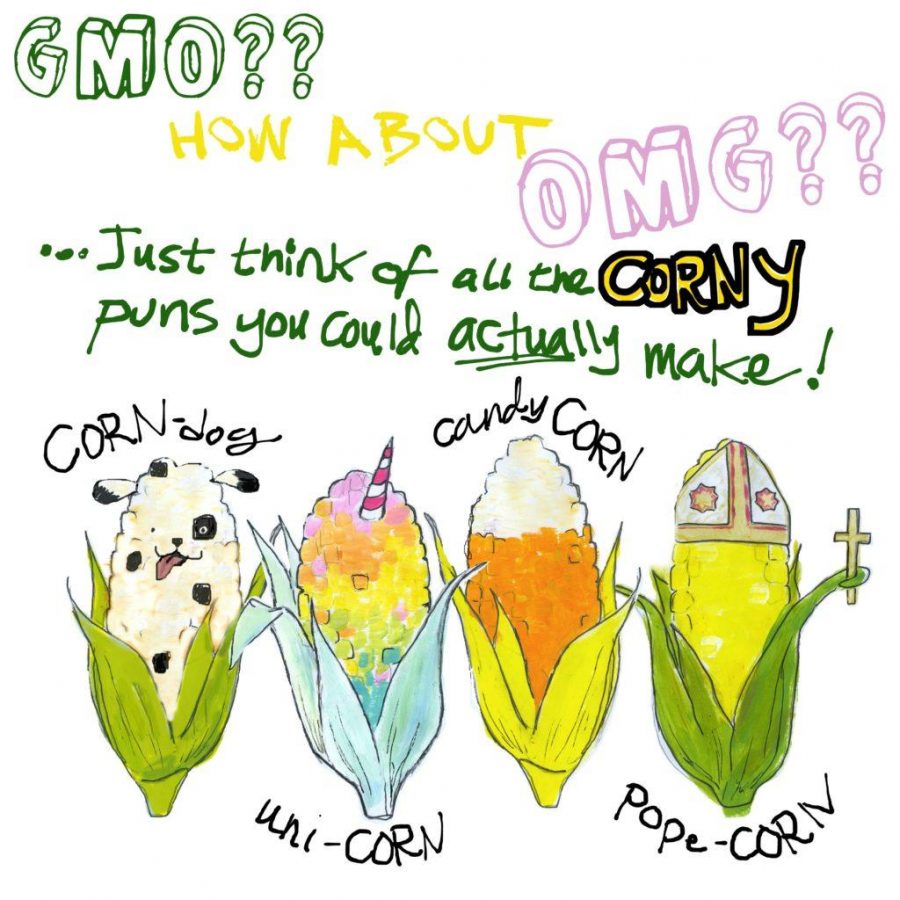Walking through the produce aisle in the middle of winter is really a spectacular thing. Even during the cold season, there is an abundance of things like sweet peppers, cucumbers, strawberries, citrus fruits, tomatoes and potatoes. Of course, these things would not be available in quite this way if it weren’t for things like industrialized mass-production agriculture, robust international trading and GMOs.
Genetically modified organisms (GMOs) are different from traditionally grown and harvested foods in that they are the product of direct genetic manipulation. This means that some sequence of DNA was changed, removed or inserted. Even stretches and sequences from one plant could be incorporated into the genome of a different plant. This is not scary, and this is not much different from the way we have always been doing agriculture and domestication. Traditionally, we could not manually manipulate the sequences of DNA that direct and influence the development of our food. We simply had to wait, every generation, for mutations. Mutations in the DNA of our crops arose naturally (from copying errors, duplications, deletions) and altered the subsequent sequencing of the four nitrogenous bases of life’s DNA. These changes in genotype could eventually lead to changes in phenotype, things like sweetness, an easier-to-harvest fruiting body, different pollination preferences, drought tolerance and beauty.
This is referred to as “artificial selection,” and it’s essentially indirect genetic modification. Since there are only four nitrogenous bases that make up the DNA of all life, when you do something like insert a part of a foreign genome you are only incorporating a particular sequence of those same letters somewhere into the giant target sequence. You’re not making monsters, you just have direct access to the crop’s blueprint.
GMOs are not harmful to human health, nor are they any more environmentally destructive than any other agriculture crop. According to the Genetic Literacy Project, “[These] crops result in a sharp reduction of insecticide use, dramatically lowering pesticide exposure. And herbicide tolerant crops in other countries have allowed farmers to switch to much less toxic chemicals… There are no safety or health concerns, either, according to the global consensus.” These plants are first and foremost products of a long history of intensive and selective agriculture, technology which has simply gotten better. GMOs are nothing to be afraid of, nothing unnatural, nothing truly foreign or absurd and nothing environmentally or otherwise dangerous. They will not give you cancer and they will not suddenly infect neighboring crops with some alien disease. GMOs could be more efficient, more resilient and even better-tasting than traditionally selected agricultural products. They could alleviate a lot of food-related crises around the world. GMOs could be the next best thing to happen to world commercial agriculture since nitrogen-based fertilizer.
Since we’re already talking about all of the genetic modifications that make possible our luxurious, year-round, affordable vegan lifestyle, we must talk about grafting in order to really solidify the absurdity of GMO aversion. According to “A History of Grafting,” “Grafting can be defined as the natural or deliberate fusion of plant parts so that vascular continuity is established between them… and the resulting genetically composite organism functions as a single plant… For example, a scion of a red-flowering rose grafted on a white rose stock will continue to produce red roses rather than pink (hybrid) roses.” This practice of fusing two originally distinct organisms, seems to be making a whole different monster than a hybrid: the interbreeding of two distinct things that form a new but (basically) naturally-occurring thing. This was even practiced as early as Mesopotamia; agriculture itself is inextricably tied to genetic modification.
If you’re wondering why Europe has banned GMOs, or why prominent groups in the United States advocate for a similar political move, or why your sister thinks she’s better than you because she only shops at Whole Foods, it’s because they have misinterpreted ethical and economic law as environmental and ideological direction. GMOs are banned for “precautionary” reasons in the EU, largely due to their classification as “Biotechnology” and the unclear legal precedent surrounding such a thing. Essentially, the government in the EU at the time of GMO emergence was incompetent. In the U.S., however, the laws were interpreted a little differently. They “rested on the assumption that there was nothing unique in employing genetically modified seeds to produce, for example, a longer lasting tomato, since the end product was essentially identical to that grown from conventional seeds,” according to the Council on Foreign Relations. Additionally, due to the attention drawn to the consumable GMOs, loopholes were created for things like pesticide production. With pesticides and repellants, since they must be effective in killing or deterring pests, you can imagine that they ought to be the GMOs in focus, rather than corn that doesn’t need as much water.
All in all, GMOs are not to be feared. They’re the future of an agricultural system that needs to feed an ever-growing human population with greater efficiently and higher demands. Don’t let people scare you into spending more money on organic produce, or guilt you into a GMO-free diet because it’s “natural.” GMOs are practical and safe.



Caroline Time • Mar 27, 2017 at 2:14 pm
Look up the effects of GMO products and your autoimmune system. I think I’ll pass.